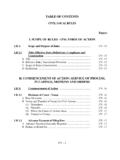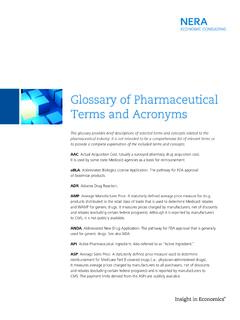Transcription of Guideline on good pharmacovigilance practices (GVP)
1 See websites for contact details European Medicines Agency Heads of Medicines Agencies The European Medicines Agency is an agency of the European Union European Medicines Agency and Heads of Medicines Agencies, 2013. Reproduction is authorised provided the source is acknowledged. 19 April 2013 EMA/169546/2012 Guideline on good pharmacovigilance practices (GVP) Module X additional monitoring Draft finalised by the Agency in collaboration with Member States 25 May 2012 Draft agreed by ERMS FG 30 May 2012 Draft adopted by Executive Director 22 June 2012 Released for public consultation 27 June 2012 End of consultation (deadline for comments) 24 August 2012 Revised draft finalised by the Agency in collaboration with Member States 21 March 2013 Revised draft agreed by ERMS FG 27 March 2013 Revised draft adopted by Executive Director as final 19 April 2013 Date for coming into effect 25 April 2013 Guideline on good pharmacovigilance practices (GVP) Module X EMA/169546/2012 Page 2/9 Table of contents Introduction.
2 3 Structures and processes .. 4 Principles for assigning additional monitoring status to a medicinal product .. 4 Communication and 4 Operation of the EU network .. 5 Criteria for including a medicinal product in the additional monitoring list .. 5 Mandatory scope .. 5 Optional scope .. 5 Criteria for defining the initial time period of maintenance in the additional monitoring list .. 6 Mandatory scope .. 6 Optional scope .. 6 Roles and responsibilities .. 6 The European Commission .. 6 The Agency .. 6 National competent authorities .. 7 The pharmacovigilance Risk Assessment Committee (PRAC) .. 7 The Marketing authorisation holder .. 7 Creation and maintenance of the list .. 8 Process for the creation of the list .. 8 Process for the maintenance of the list .. 8 Inclusion of medicinal products in the 8 Black symbol and explanatory statements .. 9 Transparency .. 9 Guideline on good pharmacovigilance practices (GVP) Module X EMA/169546/2012 Page 3/9 Introduction pharmacovigilance is a vital public health function with the aim of rapidly detecting and responding to potential safety hazards associated with the use of medicinal products.
3 A medicinal product is authorised on the basis that, its benefit-risk balance is considered to be positive at that time for a specified target population within its approved indication (s). However, not all risks can be identified at the time of initial authorisation and some of the risks associated with the use of a medicinal product emerge or are further characterised in the post-authorisation phase of the product s lifecycle.. To strengthen the safety monitoring of medicinal products, the 2010 EU pharmacovigilance legislation, further amended in 2012, has introduced a framework for enhanced risk proportionate post-authorisation data collection for medicinal products, including the concept of additional monitoring for certain medicinal products. As defined in Article 23 of Regulation (EC) No 726/2004 (REG) and Article 11 of Directive 2001/83/EC (DIR), the Agency shall, in collaboration with the Member States, set up, maintain and make public a list of medicinal products that are subject to additional monitoring (hereafter referred to as the list ).
4 These medicinal products will be readily identifiable by an inverted equilateral black triangle as stipulated in the Implementing Regulation (EU) No 198/2013. That triangle will be followed by an explanatory statement in the summary of product characteristics (SmPC) as follows: This medicinal product is subject to additional monitoring. This will allow quick identification of new safety information. Healthcare professionals are asked to report any suspected adverse reactions. See section for how to report adverse reactions. A similar statement will also be included in the package leaflet. This explanatory statement should encourage healthcare professionals and patients to report all suspected adverse reactions. The pharmacovigilance provisions of Regulation (EC) No 726/2004 and of Directive 2001/83/EC have been recently amended by Regulation (EU) No 1027/2012 and Directive 2012/26/EU respectively. These amendments have impacted on the content and the scope of Article 23 of the REG and will be applicable for centrally authorised products on 5 June 2013.
5 This GVP takes into account the new provisions relating to the list of products which require additional monitoring. Post-authorisation spontaneous Adverse Drug Reactions (ADR) reports remain a cornerstone of pharmacovigilance . Data from ADR reports is a key source of information for signal detection activities (see Module IX). Increasing the awareness of healthcare professionals and patients of the need to report suspected adverse drug reactions and encouraging their reporting is therefore an important means of monitoring the safety profile of a medicinal product. The concept of additional monitoring originates primarily from the need to enhance the ADR reporting rates for newly authorised products for which the safety profile might not be fully characterised or for products with newly emerging safety concerns that also need to be better characterised. The main goals are to collect additional information as early as possible to further elucidate the risk profile of products when used in clinical practice and thereby informing the safe and effective use of medicinal products.
6 This Module is divided in two sections: provides general principles for assigning additional monitoring status to medicinal products and on communication and transparency aspects. describes the operation of the EU network regarding the supervision of additional monitoring status, the communication strategy and the impact on pharmacovigilance activities. Guideline on good pharmacovigilance practices (GVP) Module X EMA/169546/2012 Page 4/9 Structures and processes Principles for assigning additional monitoring status to a medicinal product All medicines are authorised on the basis that the benefit of treatment is considered to outweigh the potential risks. To come to this conclusion for a marketing authorisation, data from clinical trials conducted during the development of a medicine are assessed. However, adverse reactions which occur rarely or after a long time may become apparent only once the product is used in a wider population and/or after long term use.
7 In addition, the benefits and risks of a medicine may have been evaluated in conditions which may differ from those in everyday medical practice, clinical trials might exclude certain types of patients with multiple co-morbidities or concomitant medications. Therefore, after a medicine is placed on the market, its use in the wider population requires continuous monitoring. Marketing authorisation holders and competent authorities continuously monitor medicinal products for any information that becomes available and assess whether it impacts on the benefit-risk profile of the medicinal product. However, for certain medicinal products enhanced post-authorisation data collection is needed to ensure that any new safety hazards are identified as promptly as possible and that appropriate action can be initiated immediately. Therefore, in order to strengthen the monitoring of certain medicinal products and in particular to encourage the spontaneous reporting of ADRs, the concept of additional monitoring has been introduced.
8 additional monitoring status can be assigned to a medicinal product at the time of granting a marketing authorisation or in some cases at later stages of the product life cycle for a medicinal product for which a new safety concern has been identified. The additional monitoring status is particularly important when granting marketing authorisation for medicinal products containing a new active substance and for all biological medicinal products, which are priorities for pharmacovigilance . Competent authorities may also require additional monitoring status for a medicinal product which is subject to specific obligations the conduct of a Post-Authorisation Safety Study (PASS) or restrictions with regards to the safe and effective use of the medicinal product. Communication and transparency The additional monitoring status needs to be communicated to healthcare professionals and patients in such a way that it increases reporting of suspected adverse reactions without creating undue alarm.
9 This can be achieved for example by highlighting the need to better characterise the safety profile of a new medicinal product by identifying additional risks but placing those potential risks in the context of the known benefits for this product. A publicly available list of medicinal products with additional monitoring status should be kept up to date by the Agency In addition, healthcare professionals and patients should be enabled to easily identify those products through their product labelling. The publication of the list together with appropriate communication should encourage healthcare professionals and patients to report all suspected adverse drug reactions for all medicinal products subject to additional monitoring. Guideline on good pharmacovigilance practices (GVP) Module X EMA/169546/2012 Page 5/9 Operation of the EU network Criteria for including a medicinal product in the additional monitoring list Mandatory scope According to Article 23(1) of Regulation (EC) No 726/2004 (REG), it is mandatory to include the following categories of medicinal products in the list: medicinal products authorised in the EU that contain a new active substance which, on 1 January 2011, was not contained in any medicinal product authorised in the EU; any biological medicinal product not covered by the previous category and authorised after 1 January 2011; products for which a PASS was requested at the time of marketing authorisation (point (cb) of Article 9(4) of Regulation (EC) No 726/2004 and point( b) of Article 21a of Directive 2001/83/EC).
10 Products authorised with specific obligations on the recording or suspected adverse drug reactions exceeding those referred to in Chapter 3 of Directive 83/2001/EC (point (cb) of Article 9(4) of Regulation (EC) No 726/2004 and point (c) of Article 21a of Directive 2001/83/EC); products for which a PASS was requested following the grant of marketing authorisation (Article 10a(1) of Regulation (EC) No 726/2004 and point (a) of Article 22a (1) of Directive 2001/83/EC); products which were granted a conditional marketing authorisation (Article 14(7) of Regulation (EC) No 726/2004)); products authorised under exceptional circumstances (Article 14(8) of Regulation (EC) No 726/2004) and Article 22 of Directive 2001/83/EC)). Optional scope As set out in Article 23(2) of Regulation (EC) No 726/2004 there is the possibility to include in the list medicinal products subject to conditions, not falling under the mandatory scope. This can be done at the request of the European Commission or a national competent authority, as appropriate, following consultation with the pharmacovigilance Risk Assessment Committee (PRAC).















